
The Painter’s Contract
Ieva Kulakova
02/03/2012
Ģirts Muižnieks’s exhibit Parfīms (Perfume) is on view at the gallery Māksla XO in Riga (Latvia) through March 6.
Many have said that “writing about music is the same as dancing about architecture.”[1] The same holds true for painting. Here each expression is like a decorative piece of crochet or a mental pirouette. It’s like an attempt to describe one language with another: in the end you can’t express much of anything. A relatively pointless activity. And god forbid you later see yourself in the scene from Breugel’s The Blind Leading the Blind! [2] A non-complimentary but rather precise warning for a contemporary art reviewer.
Why I’ve chosen to speak about this right now—in the case of Ģirts Muižnieks’s exhibit Parfīms—I’ll try to describe a bit later. But the reference to Bruegel has a direct associative source: the Enlightenment thinker Johann Joachim Winckelmann’s [3] essay Erinnerung über die Betrachtung der Werke der Kunst [4] refers to a metaphor about the blind. Living in mid-eighteenth-century Rome, he writes, “In the couple years I have spent in Italy, I observe almost every day how travelers, particularly the young, follow the advice of the blind, who serve as guides in examining objects, and indifferently walk past masterpieces of art.” This short text by Winckelmann, if you cast aside knowledge about the specific Enlightenment-era aesthetic ideal, is very precise. His three pieces of advice for independence judgment of art are very capacious. The first recommends that when looking at a work, one must set aside everything that “attests to praiseworthy diligence and assiduity,” because “talent can be seen where there is no diligence.” Beauty, to his mind, is the second thing that one must pay attention to. “For thinking people,” he writes, “the highest artistic theme is a person or at least his outer image, which it is just as difficult for an artist to study as it is for a wise man to study a person’s soul. What is more, the most difficult thing (which might seem strange at first) is that this doesn’t yield either to counting or to measurement.” Winckelmann associates the third aspect with the trimmings of a work and mind, or: “if mastery appears in literature as the clarity and power of expressing thoughts, then it appears in art as the freedom and conviction of the artist’s hands.” Winckelmann’s position is clear: he is for the freedom of the artist and the viewer. One may be found in talent and mastery; but the other, in knowledge and the practice of viewing.
Yet before I turn to an analysis of Muižnieks’s exhibit Parfīms, I first to take another step back. The analogy that I wish to use here is also borrowed. Only this time it comes from one of our contemporaries, the American art critic Dave Hickey’s [5] wonderful book of essays The Invisible Dragon [6], which is dedicated to beauty. However, the metaphor that I will repeat is addressed to two relationship models between a work of art and its viewer. This lets us more clearly recognize our role. Hickey, who first apologizes for the vulgarity, initially describes the relationship between a work of art and its viewer as sadomasochistic. The only question is, which side does the viewer take in this relationship model? In other words, if the viewer signs his viewing “contract” with the work of art independently, he assumes the status of Masoch’s victim. Hickey writes: “The rhetoric of beauty tells the story of those beholders who, like Masoch’s victim, contract their own submission—having established, by free consent, a reciprocal, contractual alliance with the image. The signature of this contract, of course, is beauty. … In any case, this vertiginous bond of trust between the image and the beholder is private, voluntary, and a little scary. And, since the experience is not presumed to be an end in itself, it might, ultimately, have some consequence beyond the encounter.” In turn, this contact (the encounter between the beholder and the work of art) takes place through “therapeutic institutions,” which is what Hickey calls official art institutions (and to which I would add the review section as the overseer of official meetings). The beholder assumes the role of the “silly demimondaines in Sade’s Philosophy of the Bedroom.” Hickey says that the “experience of art within the therapeutic institutions, by contrast, is presumed to be an end in itself. Under its auspices, we [the beholder] play a minor role in the master’s narrative—the artist’s tale—and celebrate his autonomous acts even as we are offhandedly victimized by the work’s philosophical power and ruthless authority. … Whatever we get, we deserve—and what we get most prominently is ignored, disenfranchised, and instructed. Then we are told that it is ‘good’ for us.”
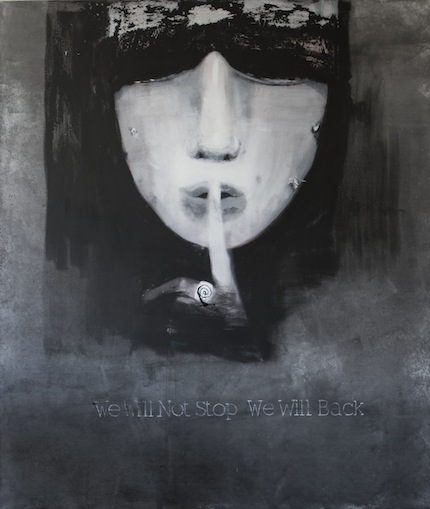
Both Winkelmann and Hickey are deliberate apologists of beauty. Except that if Winkelmann says that “beauty exists in the multiplicity of the whole” and compares this with a “philosopher’s stone,” which each artist strives to discover, but only the rare few actually finds, then Hickey places beauty in the eye of the beholder. In other words, it depends on the direct relationship between the beholder and the image; that’s why it is important here to preserve the autonomy of perception.
As you might have noticed, I am simply trying to liberate Muižnieks’s painting from the need to describe it with the help of the mind, and to say that everyone will find what he wants there, and to urge viewers toward an independent encounter with it. “Essentially, painting doesn’t have content at all – that’s why it should be perceived emotionally,” [7] says the artist. I’m left to say that it is like a mirror, where everybody sees himself and receive what he wants, that is, if there exists this inner necessity. And if someone is looking for joy here, he will get if; if someone is looking for lightness, he will see that, too. Also: beauty, play, decadence, drama—whatever you wish.
However, I promised to justify why this time I must speak so acutely of the difficulty of describing painting, because essentially the previously outlined problems can also be addressed to a broader art territory. This is because Muižnieks, in his painting, has succeeded in renouncing everything that the mind and logic can describe; he works in the territory of pure painting. And a formal analysis of art would in this case be an end in itself, and would essentially not say anything at all. That’s why one is left either to describe his painting process—how he puts the canvas on the floor, begins to move around it, then sit in a chair more than he paints, looks at the canvas, meditate and smoke; how by working with his head down the blood rushes to his head; how he is accompanied by luck; he lays the paint on and it is better; then suddenly everything is just the opposite and he has to wipe it all off, and he is disappointed, and so on—or to draw attention to my own personal feelings as a beholder of the work of art. But I will continue, crossing back and forth between both of these paths.
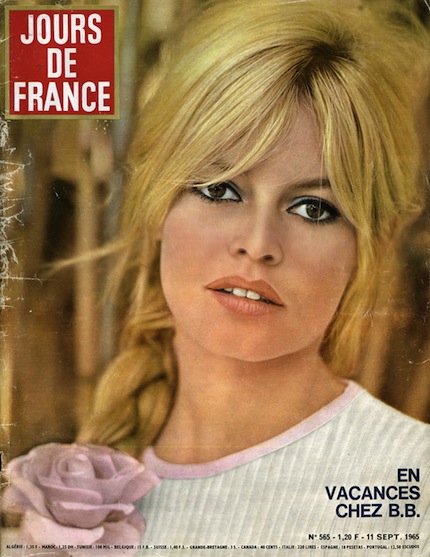
Overall, Ģirts Muižnieks’s painting is strong and beautiful. In my opinion, the ten works on display in the exhibit Parfīms together form an eclectic impression, but this is very engaging. Here I should explain that I have my own theory about the “black point” to which I have arrived, organizing exhibits and collaborating on setting them up. It is based on the recognition that things that are too perfect are boring. That’s why it’s not a bad idea to include in an exhibit something different, something that stands out from the whole, because precisely toward this inner incorrectness one may acquire a refreshing point of reference for perceiving the rest of the exhibition. There are several of these in the exhibit Parfīms. The most conspicuous, of course, is the central work, with an immortalized message from hackers and, along with its repetition, a promise from the artist: “We will not stop, we will back.” This monochromatic and realistic portrait of a woman, slightly crookedly composed on a gray background (separately exhibited), isn’t easily attributed to Muižnieks’s hand. Only the sign on the ring on the woman’s finger, with she holds to her lips, secretively shushing, is a link with the rest of the works. There isn’t reason to guess how much, by repeating this message, the artist is a brave supporter of the Palestine liberation movement (the hackers sign as such). Rather, we can perceive this as an advertisement for a film that is yet to be shot, or an exhibit yet to be painted.
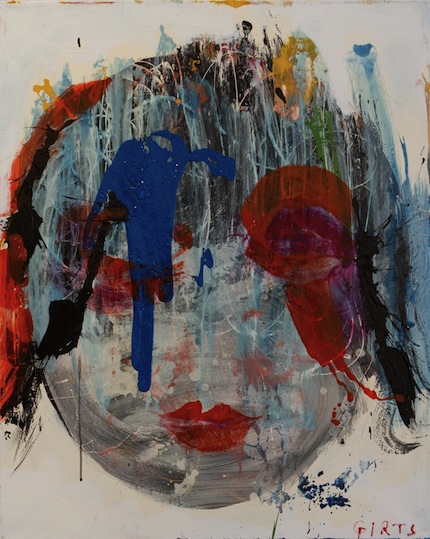
Yet someone is looking at us from each of the paintings. The sense of this observer’s presence is shocking. What is more, this is heightened even more by other exhibit at the gallery Māksla XO, Elvīra Pinne and Rūdolfs Pinnis’s show Maskas. Here, Muižnieks’s eyes become “gentle” against Pinnis’s “toothy” ones, but this gaze literally eats the beholder and it is impossible to hide from it. Only the Palestinian, covering her eyes, quietly warns, “It won’t end!” But so that you don’t get the wrong idea—this isn’t a terrible exhibit, though it is terribly beauty!
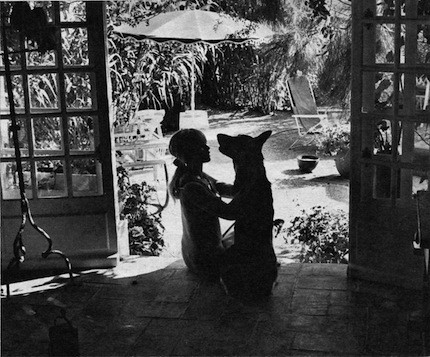
“You can’t hide from yourself,” [8] says Muižnieks, and publicly mentions three sources of inspiration for the creation of this exhibit: the 1965 magazine Jours de France (Nr. 565), where the main topic is a description of French diva Brigitte Bardot’s vacation, accompanied by black-and-white photos; his father Oskars Muižnieks’s 1956 set design sketches for the Daile Theater’s production of Mary Stuart; and the previously mentioned hacker’s message left on the artist’s website. We can also add to this list Eduard Manet’s [9] famous 1863 painting Olympia, which at the time so upset the minds of Parisians, the image of the prostitute shamelessly offered for view, and Muižnieks’s house cat, Joko. (The latest recommendation, from my side, is pure speculation.) At other times as well, the points of departure for the artist’s exhibits have seemingly been discovered by chance. These include a fly and a doll’s head, which buzzed and were reflected around the viewers in previous exhibits.
Sometimes works by other artists have been engaging for him. For example, the transformed version of Olympia on view in this exhibit make us recall his earlier Fudžitas motīvu (2003)—a paraphrase about the sleeping woman in Tsuguharu Foujita’s work. If you wish, you can see in both the image of Danaya, fooled by Zeus.
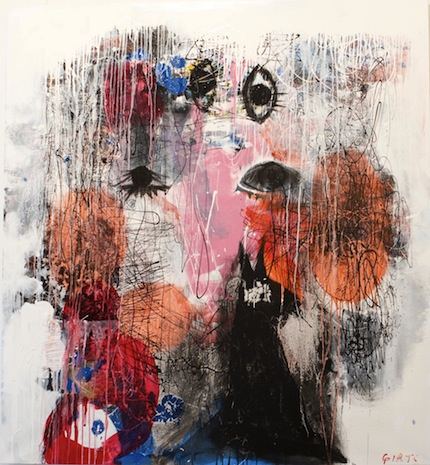
Muižnieks’s works are not “a la prima,” but his exhibits are. They are created quickly. He doesn’t hide the fact that this usually takes places about two weeks before the opening. Then he completely abandons himself to art. However, his works can also be made over the course of several years. When assessing the readiness of each work, of decisive significance is that which he calls štīme. I’d say this is an internal tension within a work which must be tightened to the maximum degree. He creates his works simultaneously: while one is drying, he works on another. Layering is also important, where pure colors on the canvas blend through their clear covering. For example, in the exhibit’s leading work, Parfīms (also known as a cat), there are about five cats. Muižnieks also says that “it is important to leave places that are nice and professional, but also for there to be something incorrect and ugly—like the awful white color in the cat pictures, which contrasts with Latvian painting’s sense of craftsmanship.” [10] The finishing of the surface is another question. For this, Muižnieks uses either black or red lacquer. However, he doesn’t experiment with materials and mostly paints with oil alkyde, because this is more lively than acrylic. Yet he can also mix these in a single work. And if the picture comes out too dense, he simply covers half of it.
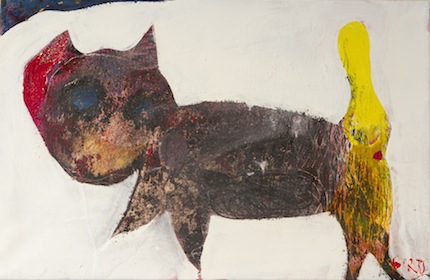
Nevertheless, the artist has often said that he doesn’t paint at all, but allows the paintings to paint themselves. He doesn’t create compositions, and the colors lay themselves on and develop instinctively; this is also how they blend on the canvas—he uses the brush only fragmentally, as well as the easel, and he doesn’t have any palettes in his studio. What is more, for some time now he has spoken of an imaginary metaphysical task for painting: “A person is limited in his abilities. Exhilaration and beauty exist (speaking of painting, beauty is usually a curse word; we don’t use it). But will humanity develop so far that it is able to perceive some godly, superhuman beauty or superhuman art or artisticness? How would it be if we were to make something that went outside human boundaries? Where is the border: can you make a picture, and then have a person walk up to it and faint?”[11]
I’ve thought about this too, only from a different angle. How is it possible to arm a viewer to perceive a work of art—how and in what way to “bang him over the head,” so that he opens his minds and abandons himself to perceiving sensations? Here the first impulse on viewers would be followed by a recognition of powerlessness and then surrender. But simply going into a gallery from the street, only the rare few would manage beforehand to take off his everyday armor and remain in submissive nakedness. That’s why people most often continue to operate with explanations issued by “therapeutic institutions” and follow their instructions.
Yet Muižnieks tries to avoid conscious instruction of the viewer. The suggestions made in his exhibited works also apply only to him, not the viewer. He has given all his works the same name, just like the exhibit, Parfīms; at the same time, this complicates the possibility of describing them. This point of departure for the artist liberates the viewer to a metaphysic of personal sensations. For me this is a sensation of doors to another room in the plane of Muižnieks’s paintings. And that Muižnieks’s works are those that actually look at us, instead of us at them. This “door” has a differing density, from the materiality of various sensations. The exhibit Parfīms has a work whose substantiality (the aforementioned cat) brings it almost to the status of sculptural painting, and in this way the “another world” enters our own as emotional aggression. Rejection is what takes effect first; only by getting over its prohibition can one begin to get to know it. There are also works here with the shine of a lacquered mirror surface. They physically repel you and don’t let you see what’s inside them. Yet this physical repelling is also attractive. You can try to walk past it and grow an inner indifference; bet then, at some strange angle, you notice something attractive, familiar, and the process of getting to know it can begin. But there are also works that are open and pull the viewer inside them without any restrains, offering an infinite walk in “another world,” gradually uncovering layer after layer and making one guess (or recall) where the starting point was, and where was the ending. These are all specific “perfumes.” Here the first enticement is different, followed by the further reading of the image—perception. But I am still interested in the relationship between the irrational and the rational in Muižnieks’s intuitively expressive painting and possible synchronicity of accidents. I imagine that the irrational, which is related to discovery, is more successful than its subsequent rational utilization. What appears here is the lucky energy of chance. But this is also a question that must be paid attention to—to the success of the turning point or the climax of discovery? Once again, this is a matter of individual choice.
Nevertheless, it is interesting to see how Muižnieks painting, which of him is a form of meditation, transforms into a painting of haptical sensations. [12] The answer can be read in his personal “painter’s contract,” and we can also see it in this exhibit.
________________________
[1] This expression has been used by many: Lori Anderson, Miles Davis, Elvis Costello, Steve Martin, Clara Schumann, Frank Zappa, etc.
[2] The painting The Blind Leading the Blind (1568), by Dutch Renaissance era painter Peter Bruegel the Elder (1525/30–1569).
[3] Johann Joachim Winckelmann (1717–1768) – historian, Enlightenment figure, archeologist, and founder of art history as a science.
[4] Winckelmann moved to Rome in late 1755. The essay Erinnerung ūber die Betrachtung der Werke der Kunst appeared in 1756–1758.
[5] Dave Hickey (1939), American art and culture critic.
[6] Hickey, Dave. The Invisible Dragon. Four Essays on Beauty (Los Angeles: The Foundation of Advanced Critical Studies, 1993).
[7] From the author’s conversation with artist Ģirts Muižnieks on February 10, 2012.
[8] ibid.
[9] Édouard Manet (1832–1883) – French painter whose work marks the transition from Realism to Impressionism.
[10] From the author’s conversation with artist Ģirts Muižnieks on February 10, 2012.
[11] Muižnieks, Ģirts. Favorīts [conversation with the artist] / Ģirts Muižnieks; recorded by Anita Vanaga. Māksla Plus, 200., Nr. 1.
[12] haptical: a nonverbal form of communication [from the Greek haptikos – “able to touch or grasp”].